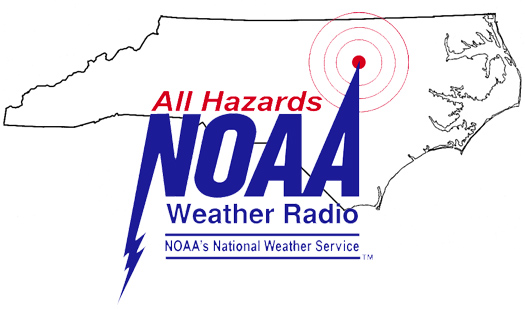
| NOAA Weather Radio in Eastern North Carolina |
| NOAA Weather Radio is a service of the National Oceanic and Atmospheric Administration, broadcasting on seven VHF Band frequencies ranging from 162.400 MHz to 162.550 MHz. These frequencies are outside the normal AM or FM broadcast bands, and are therefore not found on the average home radio. These broadcasts originate from National Weather Service Offices across the Unites States and its territories. As the Voice of the National Weather Service, more than 900 FM transmitter sites provide continuous broadcasts of the latest and up-to-date weather information. NOAA Weather Radio broadcasts can be heard as far away as 40 miles from the antenna site. The effective range depends on many factors, particularly the terrain, the quality of the receiver, and current weather conditions. The broadcast schedule consists of taped messages which are repeated every three to five minutes and are routinely revised to provide the latest and up-to-date information. The broadcasts on NOAA Weather Radio are tailored to the weather needs of the people within the receiving area, and include a variety of programming subjects. During severe weather and/or other potentially hazardous events, we may interrupt the regularly scheduled programming to substitute severe weather information (including warnings, watches, etc.), and/or other hazardous informational messages. Special NOAA Weather Radio receivers can be activated, sounding an alarm indicating that important information soon follows, and listeners should monitor their weather radios for the information. Also, tests of the warning alarm are normally conducted by the National Weather Service every Wednesday between 11:00 AM and Noon. In extreme cases, NOAA Weather Radio will be used to alert the public of non-weather related emergencies, such as earthquakes, toxic or chemical spills, national attacks, or nuclear blasts. Many local retailers or electronics stores sell NOAA Weather Radios. Also, many portable radios are including a weather band for your listening enjoyment as well. Obtain the piece of mind you've been looking for. With NOAA Weather Radio, you'll have the most dependable source of weather information at your fingertips. From day-to-day weather forecasts, to warnings of potentially dangerous storms, NOAA Weather Radio will be ready to alert you 24 hours a day, 365 days a year! Be Ready! Be Prepared! Be a NOAA Weather Radio listener today. |
| Specific Area Message Encoding (SAME) |
|
The National Weather Service has begun in improvement to NOAA Weather Radio that will improve our broadcasting to the public, and will allow listeners to obtain only the watches and warnings which they desire to receive.
|
| To program a NOAA Weather Radio which has the new SAME code feature, you need to enter a 6 digit SAME code. The first three digits are the state code, which is 037 for North Carolina. The last three digits are the county codes found above. For SAME codes in other areas, or for a tabular list of the information in the above graphic, please visit the NOAA Weather Radio Home. |
| Where to Tune In? |
| The graphic below shows the locations and frequencies of the NOAA Weather Radio transmitters which cover the Newport NWS WFO county warning area. |

| Transmitter | Counties Served |
| New Bern KEC-84 162.400 MHz |
Beaufort, Carteret, Craven, Duplin, Greene, Hyde, Jones, Lenoir, Martin, Onslow, Pamlico, Pitt |
|
|
|
| Cape Hatteras KIG-77 162.475 MHz |
Dare, Hyde, Tyrrell, Washington |
|
|
|
| Mamie WWH-26 162.425 MHz |
Camden, Currituck, Dare, Pasquotank, Tyrrell |
|
|
|
| Warsaw KXI-95 162.425 MHz |
Bladen, Duplin, Jones, Lenoir, Onslow, Pender, Sampson, Wayne |
|
|
|
| People in areas with poor reception from one of the Newport NWS transmitters should try to use a NOAA Weather Radio transmitter programmed by a different NWS office. If you live in northwestern portions of Greene, Pitt, and Martin Counties, you can try the Tarboro, NC transmitter (WXL-59) operating on a frequency of 162.475 MHz, which is programmed by the Raleigh, NC NWS. People in Martin and Washington Counties can try the Windsor, NC transmitter (WNG-537) operating on a frequency of 162.525 MHz, which is programmed by the Wakefield, VA NWS. People in southern Duplin and Onslow Counties can try the Wilmington, NC transmitter (KHB-31) operating on a frequency of 162.550 MHz, which is programmed by the Wilmington, NC NWS. | |